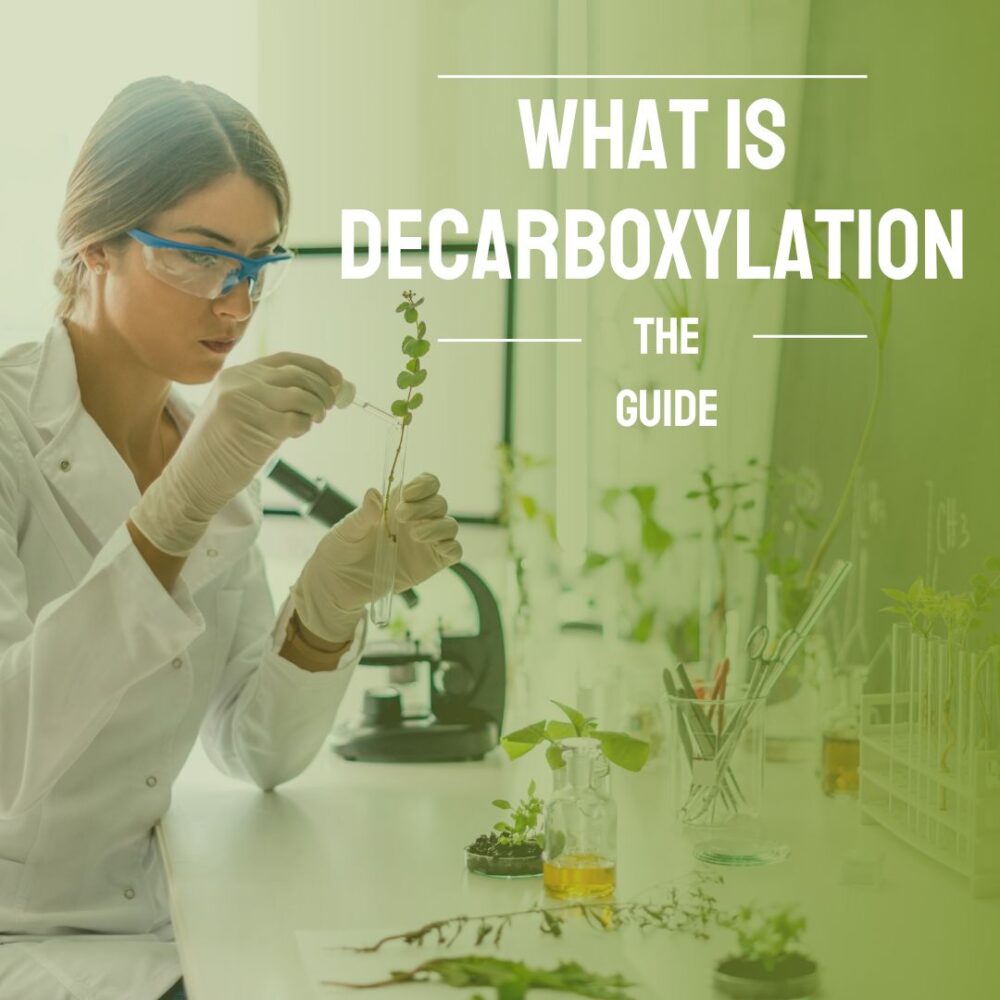
Do you need to decarboxylate cannabis flower for the cannabinoids to be active?
What is the carboxyl group on THCA and CBDA?
What temperatures and times are required to decarb cannabis flower?
Is the decarboxylation process necessary for all cannabinoids?
If you are asking these questions, you came to the right place with the right scientists!
Article Highlights
- Decarboxylation requires some heat and time, but try not to go over 250F for more than an hour.
- Crush the raw cannabis plant before mixing with oil for decarboxylation.
- Keep in a dark place for long term storage.
- Ingested cannabinoids take 30 minutes to an hour to be absorbed!
What are acidic cannabinoids?
The natural state of cannabinoids are in the "acidic" form, and are what you would find in raw cannabis flower extracts, or purifications designed to only isolate the acidic cannabinoids. While most people have heard of THC and CBD, what many people dont know is that they come from THCA and CBDA (tetrahydrocannabinolic acid and cannabidiolic acid respectively).
There are over 100 different acidic cannabinoids in the hemp and marijuana flower. We have a list of the major acidic cannabinoids and some of their properties in a prior article.
Conventional processing to purify cannabinoids has relied on heat based distillation methods, which decarboxylate the compounds found in the extract. Thus, the benefits of acidic cannabinoids have only recently been discovered.
Scientists at Natural Dos have developed a new technology to isolate acidic cannabinoids from the raw cannabis flower extract to bring those benefits to the market.
Acidic cannabinoid structures
The common structural motif of acidic cannabinoids is the presence of a carboxyl group (-COOH). This carboxyl group can be removed from the parent compound when the acid cannabinoid is exposed to certain temperatures over an extended time.
For example, the structure of CBDA and its decarboxylated form CBD is shown below:

Additionally, here is the structure of THCA and its decarboxylated form THC below:

As you can see, there is significant similarities between the different structures, but each has their own physiological impacts.
Cannabis decarboxylation processes
Typical purification processes use short path distillation. This is a method where the raw form cannabis is heated under vacuum, and cannabinoids are boiled off into a collection flask in higher purity. The heat applied will decarboxylate the cannabinoids to produce the common THC and CBD we are familiar with.
This process involves a series of ramped temperatures, such that wanted and unwanted compounds are boiled off at different temperatures. These can be collected in one after the next. Here is an example of a common setup to purify the cannabinoids:

It is common to lose the terpenes in this process, so many companies will add terpenes back into their final product.
The decarboxylated cannabis product is typically run multiple times through the short path distillation for enhanced purity.
Smoking and decarboxylation
There are multiple ways to decarboxylate cannabis besides short path distillation. The more common way is smoking. Since THCA is what is found in the marijuana flower, why does smoking cause you to get high? The heat from burning the flower instantly decarboxylates the THCA into THC, thus creating the euphoric feeling people associate with marijuana.
For THC, the psychoactive effects are only gained after decarboxylation of THCA.
Since 2018 Farm Bill made hemp legal, hemp flower for smoking has become popular. While some people enjoy this for the recreational purposes, it is not clear that there is a medicinal benefit for CBD administered in this fashion.
New research is suggesting that many of the benefits from CBD are found in CBDA. Risking side effects of smoking organic material may not be the best way to get the potential therapeutic benefits of CBD.
CBDA does not need to be decarboxylated to yield the therapeutic benefits of hemp.
Temperature and decarboxylating cannabis
A common question for people interested in the cannabis decarboxylation process is what temperature removes a carboxyl group and how much time does it take? You dont necessarily need high temperatures, but it is also dependent on time as well.
Whether you are making edibles, or just interested in the chemical reaction, we break down a published study on acidic cannabinoids that outlines the parameters for how decarboxylation can occur.
Note that the experiments used ground flower for testing.
Lower temperature and decarboxylation
In the graph below, the temperature was held constant at 90C, or 194F for 60 minutes. The graph shows the amount of decarboxylation of CBDA (blue circle) to CBD (red square) and THCA (green circle) to THC (purple square).

- After 60 minutes only about half of the acidic cannabinoids are decarboxylated
- CBDA seems to be a bit more resistant than THCA to decarboxylation
Moderate temperature and decarboxylation
Same setup as above, but this time the temperature was held constant at 105C, or 221F for 60 minutes.

- Only around 20% of acidic cannabinoids remain after 60 minutes
High temperature and decarboxylation
Same setup as above, this time the temperature was held constant at 120C, or 248F for 60 minutes.

- All the acidic cannabinoids are decarboxylated.
- At this temperature, there is not much difference in the rate of decarboxylation between THCA and CBDA.
Looking at these different charts, its clear that the temperature and time you expose the raw cannabis flower to will determine how much decarboxylation occurs. Ranging from 200F to 250F for 30 minutes to an hour appears to be the best approach.
Decarboxylating cannabis at home
What are some of the best methods if you are interested in decarbing cannabis to make edibles?
- The cannabis plant buds should be ground up so that all the cannabinoids are exposed to equal temperatures.
- Decarbing cannabis should take place in an oil such as butter or coconut oil so that all the cannabinoids are well distributed throughout the mixture. We do NOT recommend vegetable, canola, or seed oils as they have polyunsaturated fats that become oxidized when exposed to heat, and these are harmful. If you are interested in incorporating cannabis into meals, cooking with animal fats is fine since they are saturated fats and dont oxidize like the oils mentioned above.
- It is important to mix the compounds so that the heating is equally distributed during the whole process.
- It may be difficult to test the temperature of the oil mixture if this is done on a stove top, so you can use a meat thermometer, or we like to use a laser temperature gun (easy to find at Home Depot or Lowes).
- Cool the mixture immediately after finishing the decarboxylation process. This can be done at room temperature or in the refrigerator.
- If baking, you can cut short the decarboxylation process on the stove top, or do all the decarbing in the oven after mixing the plant buds with the oil. However, we have its best to do most of the decarboxylation in oil prior to addition with the baking materials and placing in the oven.
- The temperatures should not exceed 250F (120C) for more than an 45 minutes to an hour. If you are using lower temperatures under 200, you may want to increase the time to 2 hours or more to make sure you reach full cannabis decarboxylation.
Can too much heating destroy your THC and CBD?
The short answer is yes.
With too much heating for a longer period of time, you can convert the THC and CBD to other forms, such as CBN, or cause it to vaporize out of solution. The conversion of THC to CBN tends to occur at higher temperatures above 390F (200C) if left there too long.
What about terpenes
Terpenes provide a lot of health benefits, and many people try to keep them in the mix with their decarbed cannabis. Since terpenes are more fragile than THC and CBD, they can become oxidized quicker when exposed to heating and air.
Terpenes are also easily vaporized at higher temperatures. If you are interested in maintaining the terpene profile of the raw cannabis, it would be best to decarb cannabis at a lower temperature.
Can you decarb cannabis without adding heat?
If you have a cannabis infused product or tincture it can undergo a slow conversion. This can also happen with raw plant as well if left out. Decarboxylation can occur when it is exposed to sunlight over time. This process is slow, but decarboxylation occurs when the sunlight adds energy to the THCA and CBDA.
We recommend storing your cannabis in a mason jar or other container that is brown glass, or in a dark place.
How to calculate how much decarbed product you have
When determining amount of THC and CBD of your decarbed cannabis, you need to multiply by 0.88 to get the final product. This is because the acidic cannabinoids lose CO2 (carbon dioxide) when the get decarboxylated.
If you know the starting concentration, say 1000mg of CBDA, then the final amount of CBD should be around 880mg.
Do I need to decarb cannabis
It depends!
If you are looking for the psychoactive effects of THC, then this would be the process you are looking for.
However, the acidic cannabinoids, such as CBDA, have many health benefits in their natural state. Natural Dos specializes in maintaining the acidic cannabinoids found in the raw cannabis plant.
Acidic cannabinoids, such as CBDA, have over 450% greater absorption than their decarbed forms, and are now being recognized for some of their amazing immune and anxiety benefits.
Summary
Cannabis decarboxylation can be a complicated topic, but if you follow these guidelines, you can get a great decarbed product. Be mindful of the heat, and make sure to break up the cannabis plant when are mixing.
Best of luck and have fun!
FAQ- What is decarboxylation?
How do you decarboxylate a bud?
To decarboxylate a bud and convert either the THCA to THC or CBDA to CBD requires 2 components, heat and time. Getting either one can convert your cannabinoids to unwanted by products.
While both CBDA and THCA convert at different rates this protocol will be able to do both without harming the bud:
Heat the bud at 220F for 55 minutes. This can be done in the oven with controlled temperatures while the bud is covered in tinfoil.
Does decarboxylation make edibles stronger?
Yes, the natural form of the psychoactive delta-9 THC cannabinoid that is found in the marijuana flower is THCA, which is not psychoactive. Thus, decarboxylation of THCA into delta-9 THC is needed to make edibles stronger if you are looking for the psychoactive effect.
How long does decarboxylation take for edibles?
Decarboxylation of THCA into the psychoactive THC is dependent on time and temperature. It is typically recommended to decarboxylate flower by heating in butter or oil on the stove or in tinfoil in the oven before using in edibles. This is because you dont typically get complete decarboxylation if directly cooking in the edible mixture.
In the oven, it takes 55 minutes at 220F to fully decarboxylate.
